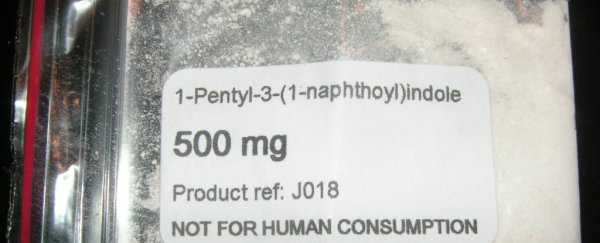An Australian chemist has created a simple colour-change test that can detect synthetic cathinones - more commonly known as bath salts.
Synthetic drugs are created to imitate the effects of drugs such as MDMA, cocaine, or marijuana by changing one or more of the molecules in the chemical structure.
These changes mean that the substances are often not picked up by tests designed for existing drugs, and can therefore get past law enforcement and border control more easily. Their effects can also be much stronger, and sometimes so unpredictable and dangerous, they seem to end up on the news a lot.
"They are similar to existing, often legal drugs, but are tweaked in the manufacturing process to produce slight changes in chemical structure," said Mark Tahtouh, team leader of forensic drug intelligence for the Australian Federal Police. "That makes them hard to detect to start with, and also to identify if they're illicit."
Right now, if a drug is suspected to be a synthetic cathinone, the substance would have to be sent to a lab to be analysed – a long and costly process that can seriously slow down any type of intervention.
"Lab-based instrumental techniques take much longer, and that doesn't include the time to get the substance to the lab and whether other matters may require priority and urgent action," says Tahtouh.
The new colour test, designed by chemist Morgan Philp from the University of Technology, Sydney (UTS), should help law enforcement stop huge shipments of the substance, while not holding up other items.
"Cathinones are typically made in China or India and sent here in disguise," said Philp. "If police or customs had early warning that a substance was suspicious and should undergo proper instrumental analysis, they would be able to intervene and prevent the drug reaching the streets."
The best thing about the test is how simple it is to use – it doesn't require specialists to perform it.
You only need a pinhead-amount of the substance, and by adding three reagents and heating the mixture to 80 degrees Celsius, you can tell by a yellow or orange colour change if the substance is synthetic cathinone. The whole thing takes a total of 5 to 10 minutes.
"Colour tests are quick, easy to perform and don't require specialisation on the part of the tester," said Tahtouh.
"A positive result doesn't give a definitive result but it does point us in the right direction. If we have someone in custody and are suspicious about a quantity of white powder, for example, we need to act quickly."
The research has been published in Forensic Chemistry.
UTS Science is a sponsor of ScienceAlert. Find out more about their research.
